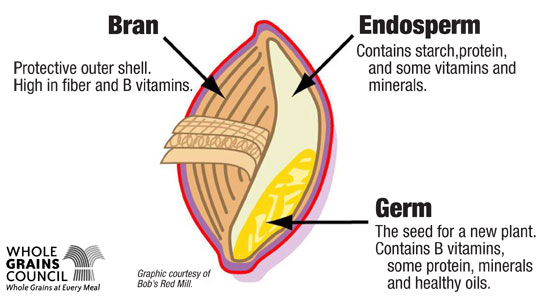
All grains, when they grow in the field, have three parts: the bran, germ and endosperm, as shown in the illustration here. Whole grains or foods made from them contain all the essential parts and naturally-occurring nutrients of the entire grain seed. Enriched (”white”) flour contains only the endosperm, while whole grain flour contains extra protein, fiber, vitamins and minerals that are found only in the bran and germ. All three parts are important!
The following are considered whole grains, when all three parts – the bran, germ, and endosperm are included:
Amaranth, Barley (lightly pearled), Brown and Colored Rice, Buckwheat, Bulgur, Corn and Whole Cornmeal, Emmer, Farro, Grano (lightly pearled wheat), Kamut® grain, Millet, Oatmeal and Whole Oats, Popcorn, Quinoa, Sorghum, Spelt, Triticale, Whole Rye, Whole or Cracked Wheat, Wheat Berries and Wild Rice.
© The Whole Grains Council / Oldways Preservation & Exchange Trust. For more information on whole grains, visit wholegrainscouncil.org.
Montana High Plains Wheat Berry Chili and Pacific Northwest Squash and Lentil Soup are two Frontier Soups that contain whole grains.
